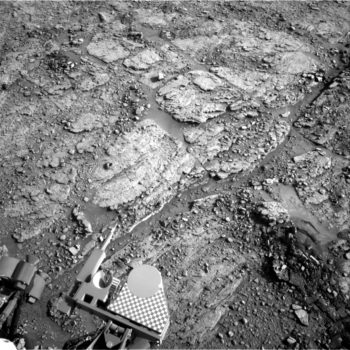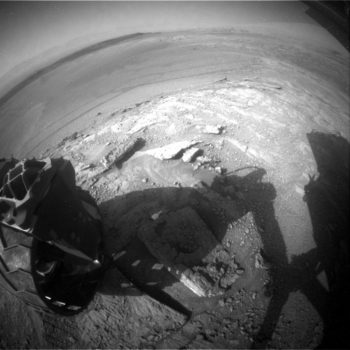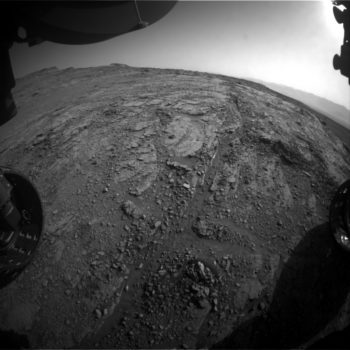NASA’s Curiosity Mars rover is now performing Sol 2491 tasks.
Source: Leonard David.com
Over the weekend, Curiosity successfully dropped off a portion of the Glen Etive drill sample. But reports Claire Newman, an atmospheric scientist at Aeolis Research in Pasadena, California, “for some reason, the sequence was interrupted, so no images of the portion were acquired.”
Diagnose the issue
Curiosity’s Remote Sensing Mast (RSM), on which the robot’s Chemistry and Camera (ChemCam), both Mastcams, and all four Navcams are mounted, briefly stopped pointing as commanded on Sol 2488.

Credit: NASA/JPL-Caltech
“The RSM worked well in the tests planned on sol 2489 and downlinked ahead of today’s planning, however. So while the engineers continue to diagnose the issue,” Newman explains, “such as whether it involves recent changes to the way we heat motors connected to the RSM, we used it again cautiously in the Sol 2490 plan.”
Avoid risk
This meant avoiding observations, Newman adds, that require the Mars researchers to look up from the surface or deck, to avoid any risk of dust piling up on lenses if the RSM became stuck there.
The net result was that most of the environmental science theme group’s cloud and dust monitoring activities could not be included, as all of them involve using Mastcam or Navcam to look near the horizon or higher up.

Credit: NASA/JPL-Caltech
Monitoring the environment
In the Sol 2489 plan, the script included some attempted dust devil imaging using the Rear Hazcams, a more recent plan scientists focused on adding extra Rover Environmental Monitoring Station (REMS) one-hour extended blocks to measure air and ground temperature, pressure, humidity, and UV radiation.
“This should result in us measuring over 37 of the 48 Mars hours contained in this two-sol plan, compared to the 13 hours we’d have measured usually, including seven periods with 5 hours of continuous REMS,” Newman adds.

Credit: NASA/JPL-Caltech
“Long periods of continuous atmospheric data are useful for tracking weather patterns, atmospheric wave activity, and even clouds that we can detect in the REMS UV and ground temperature data after sunset,” Newman points out.
The environmental group also planned Dynamic Albedo of Neutrons (DAN) and Radiation Assessment Detector (RAD) observations.

Credit: NASA/JPL-Caltech/LANL
Inlet imaging
Meanwhile, the geology science theme group planned to recover planned observations that were lost due to the RSM issue.
Because delivery of the Glen Etive sample to the Sample Analysis at Mars (SAM) Instrument Suite inlet cover and documentation imaging did not complete, the highest priority for the Sol 2490 plan was to perform the SAM drop-off and do ChemCam Laser-Induced Breakdown Spectrometer (LIBS) observations of the drill hole, Newman notes.
Other activities were ChemCam and Mastcam observations of a single rock target “Argyll,” consisting of dark bedrock with a white vein, of “Dornock” and “Thrumster,” both containing sulfate veins, and of “Tap O Noth,” a nearby bedrock target.

Credit: NASA/JPL-Caltech
Change detection
“Finally, further Mastcam imaging was performed to monitor any surface changes that may occur as a result of strong winds or intense atmospheric vortices that are able to move sand and/or dust particles,” Newman says. “Targets of this imaging included the rover deck as well as images of two surface targets called ‘Dundee 1’ and ‘Dundee 2.’ These targets were chosen because they contain both sand and bedrock, which makes it easier to spot small changes between images, such as sand shifting slightly further onto the rock.”

Credit: NASA/JPL-Caltech
These “change detection” studies are repeated at roughly equal intervals over the Mars year, and help scientists understand how sand motion and dust lifting varies with season, Newman points out, “which in turn helps us to understand how dunes form, how the surface is eroded, and how dust storms occur.”

































Leave a Comment
You must be logged in to post a comment.